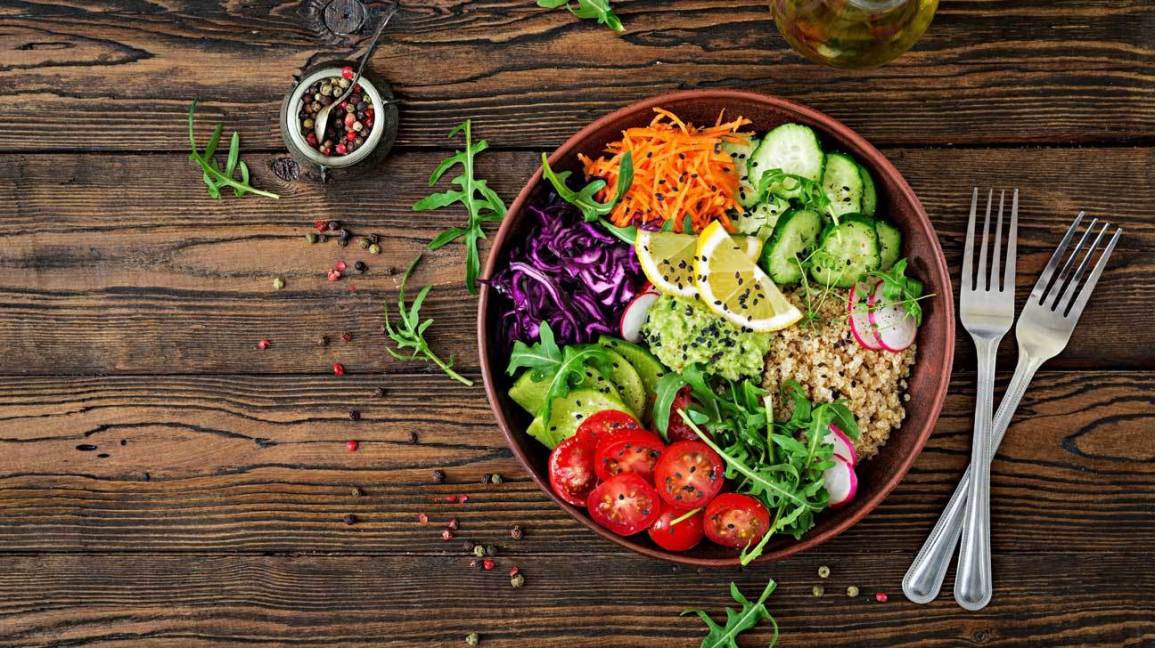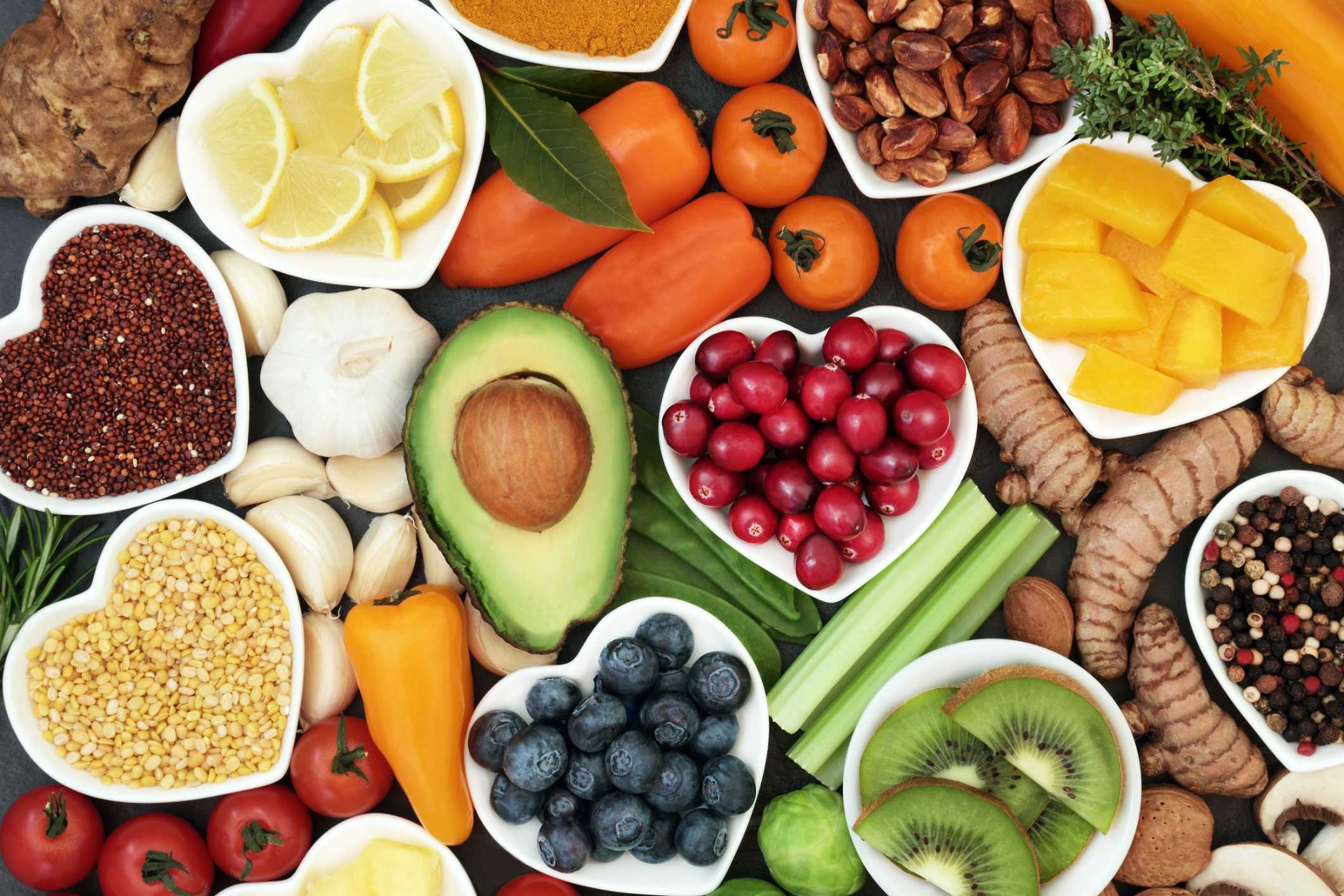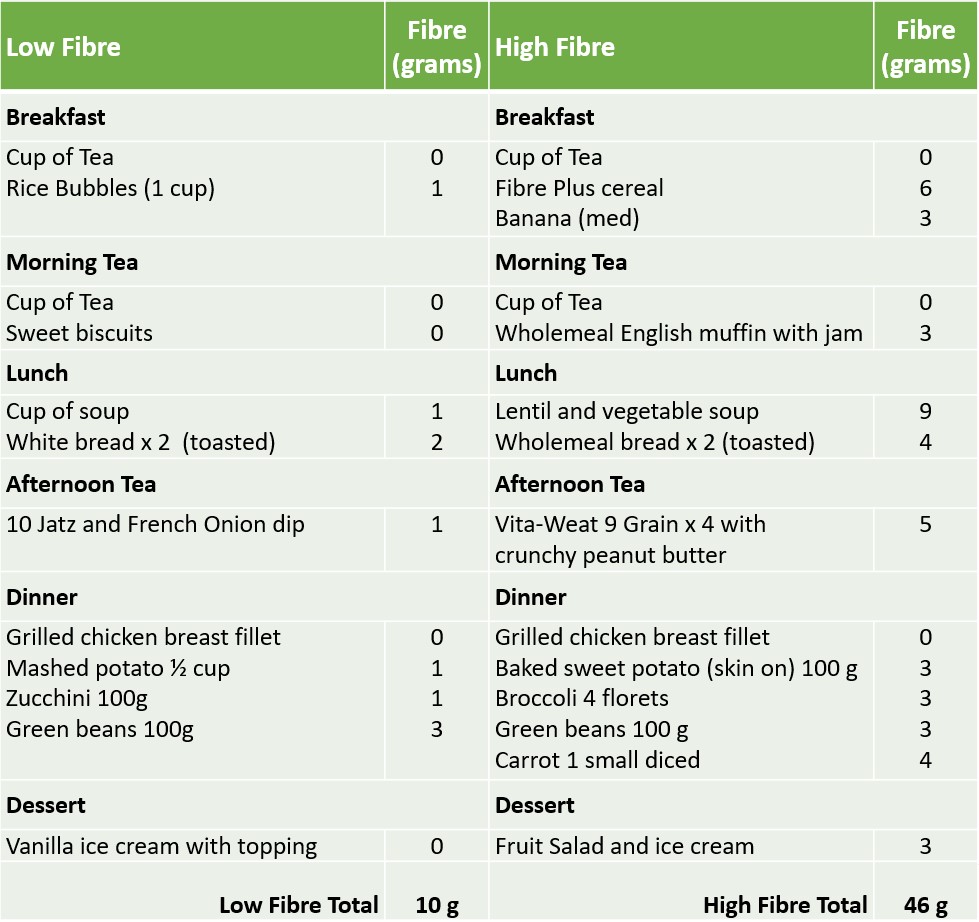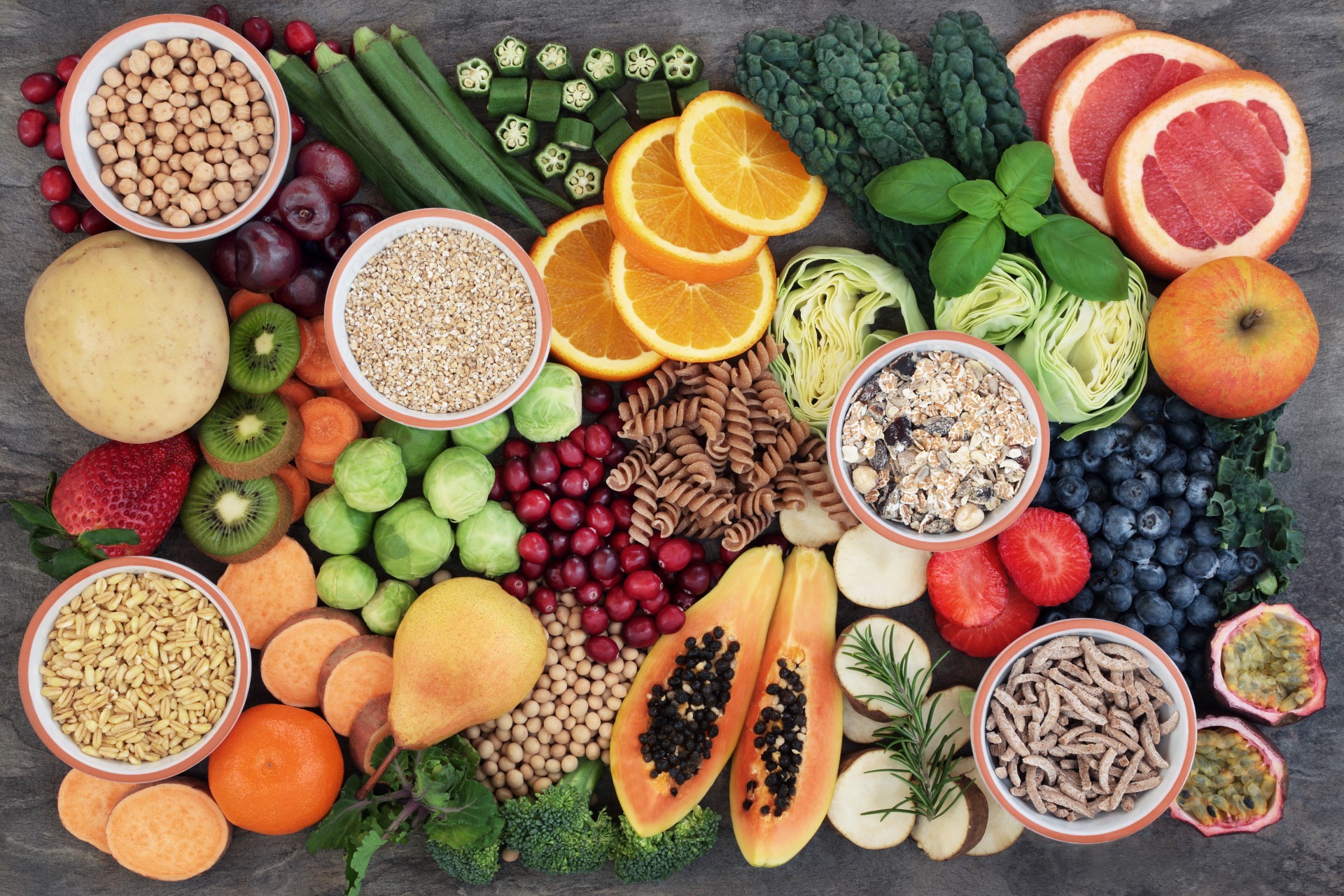Why is fibre so important?
What is fibre?
Fibre is a type of carbohydrate. It is the indigestible part of plant foods, which pass unchanged through our digestive system reaching the large intestine (colon) mostly intact.
Our bodies can't use fibre for fuel, so
it provides only minimal kilojoules (calories), but it plays a very important role
in a healthy diet.

mmm

What food groups are good sources of fibre?
Grain foods (especially wholegrains) such as bread and pasta, legumes, vegetables, fruit, nuts and seeds all contain dietary fibre.
Wholegrains and legumes are
generally higher in fibre than vegetables and fruit. However, all are good sources of dietary fibre
and they also contain other important nutrients.
mmm
How much fibre should we have each day?
There is no upper limit for the amount of fibre we should have. Australian guidelines suggest that adults should aim to consume at least 25 to 30 g daily. If you are looking to reduce the risk of chronic disease, then aim for 38 g per day.
If you are increasing your fibre intake then take it slowly, over a few days, to prevent abdominal discomfort such as diarrhoea, flatulence, cramping and bloating.
It's also important to try to spread your fibre intake out over the day.
mm
Fibre and water
go hand in hand
Fibre needs water!
When you increase your fibre intake, it's
important make sure you increase your water intake as well.

mm
There are three types of fibre

mm
The health benefits of fibre
In recent decades there has
been intense scientific and medical interest in the role of fibre in our
overall health. Where it was initially
thought that the role of fibre was to keep us 'regular', we now know that
maintaining a healthy digestive system does so much more. Different types of fibre have distinct health benefits,
so it is important to include a variety of high fibre foods in our diet.
Here is a quick summary of some of the many health benefits of fibre.
Bowel function - Fibre helps the stool to form properly and pass easily. Fibre will help to soften hard stools in constipation, and to firm loose stools in diarrhoea. Insoluble fibre, which gives bulk also draws in water, whilst soluble fibre has gel-forming properties. Both types of fibre help to form large, soft stools. Fibre also speeds up travel time through the bowel, helping to keep us 'regular' and pass stools without straining.
Adequate fibre intake also lowers pressure in the bowel which reduces the risk of developing haemorrhoids and diverticular disease. For those already diagnosed with diverticular disease it helps to manage the disease and reduces the risk of flare ups.
Blood sugar control - Including (adequate amounts of) high fibre foods helps slows the rate of digestion and absorption of carbohydrates. This leads to a slower release of glucose into the blood, reducing the likelihood of a 'spike', helping to keep blood sugar levels stable after eating. High blood sugar can lead to an increase of triglycerides in the blood, which can cause more LDL (bad) cholesterol to be produced. This is particularly important for those with diabetes or insulin resistance.
Eating high fibre foods helps with sustained energy release and can help to avoid the mid-afternoon slump which often has us reaching for a sugar hit.

Cholesterol control - Fibre can help reduce the risk of heart disease by lowering LDL (bad) cholesterol and triglycerides. Soluble fibre binds with bile salts and prevents their reabsorption which helps to lower cholesterol levels. In addition, soluble fibre can also help bind to dietary fats so that they are excreted rather than being digested and absorbed. The protective role of beta-glucan, a type of soluble fibre found in grains including oats and barley, in heart health is well known.
Lowering risk of bowel cancer - Fibre 'sweeps the bowel clean' by binding cancer causing pathogens to the stool and removing them from the body. The quicker transit time of fibre containing stools through the bowel is also thought to help keep these carcinogens from taking hold. In addition, the short chain fatty acids produced by the good bacteria in the colon reduce the ability of cells in the intestine to become cancerous.
According to the Cancer Council almost 20% of colorectal cancers could be prevented if Australians met their dietary fibre requirements.

Weight management - Many people undertaking a weight loss diet, will often limit or completely avoid carbohydrates, such as bread, pasta or rice, as they believe that they cause weight gain. Rather than following a restrictive diet, helping people to identify and incorporate good quality, high fibre carbohydrates into a healthy weight loss diet is important for sustainable weight loss. It allows people to choose from a wider range of foods, making eating and socialising more enjoyable.
High fibre foods can fill us up quicker and as fibre also slows the speed at which food moves from the stomach into the small intestine it can make us feel full for longer. This helps to reduce the amount of calories we eat. High fibre grain foods such as wholemeal bread, wholegrain crackers wholemeal pasta and brown rice can actually help managing weight in the long-term.
Many foods high in fibre, such as fruit and especially vegetables, are also high in important nutrients and low in kilojoules. This means that they are nutrient dense and energy poor - a winning combination if you are looking to manage your weight.

Gut Health - There is currently a lot of research into the gut microbiome and its role in our overall health and wellbeing. When we talk about the gut microbiome, we mean the trillions of bacteria (mostly beneficial) that live in the large intestine.
A fibre rich diet is important to feed the good bacteria and increase their numbers. Whilst we are all familiar with one of the by-products of eating fibre, gas, our good bacteria also use the fibre to also produce important by products such as vitamins and short chain fatty acids.
Some of the more well-known health benefits of a health gut microbiome include:
- feeding the cells that line the large intestine - this keeps things 'moving'
- protecting the mucous lining of the colon - to maintain the health of the gut wall
- enhancing our mental health - there is a well-established link between the gut microbiome and our mental health, through the Gut-Brain Axis
mm
At Pulse Dietetics, we understand that many people, especially those with medical conditions such as diverticulitis, inflammatory bowel disease or irritable bowel syndrome may be reluctant to add additional fibre into their diet. At Pulse, we work closely with you to educate and empower you to make choices that help enhance your health.
Please click on the link below to find out how we can help you.
mm
Simple swaps to increase your fibre each day

mm
More tips to increase your fibre intake
- Choose wholegrain, wholemeal cereal foods like bread, crackers and pasta. The less processed it is the more fibre it contains. Aim to have at least 50% of your grains as wholegrains
- Variety is the spice of life - try experimenting with some different foods such as quinoa, chia, buckwheat or barley
- You can add legumes such as lentils or chickpeas to almost any meal including casseroles, curries, soups, spaghetti bolognaise sauce or even salads
- Oats are good for more than just porridge - mix oats into meatloaf, rissoles, bread, muffins, pancakes or other baked goods
- Add some salad, such as spinach leaves, tomato, cucumber and carrot to sandwiches - every little bit helps
- Use avocado instead of butter in sandwiches or on toast
- Don't peel your vegetables - most of the fibre is found in the skin (and many of the nutrients are found just under the skin)
- Add extra diced vegetables to noodle dishes or stir-fries
- Grate or finely dice vegetables and add to bolognaise-type sauces
- Sprinkle some psyllium husk, ground linseeds or bran on your porridge, cereal, muesli, yoghurt, or add some to a smoothie

mm
Some high fibre snacks ideas
- Seeded wholemeal crackers or multigrain rice cakes with cheese or hummus (or both)
- Celery sticks or apple slices with peanut butter or hummus
- Fruit salad with a dollop (or 2) of your favourite yoghurt
- Smoothie with frozen banana, berries, or any fruit you enjoy, and add a handful of oats (you can even add vegetables, like celery, cucumber or spinach, to your smoothies!)
- A handful of nuts or seeds and you can add some yoghurt if you like
- Chia pudding is easy to make and it tastes delicious
- Muesli bars

mmm
At Pulse, we know that an adequate fibre intake is essential for maintaining good health and managing many health conditions.
If you would like to talk to us about your personal dietary needs, please click on the link below to contact us to find out how we can help you.

